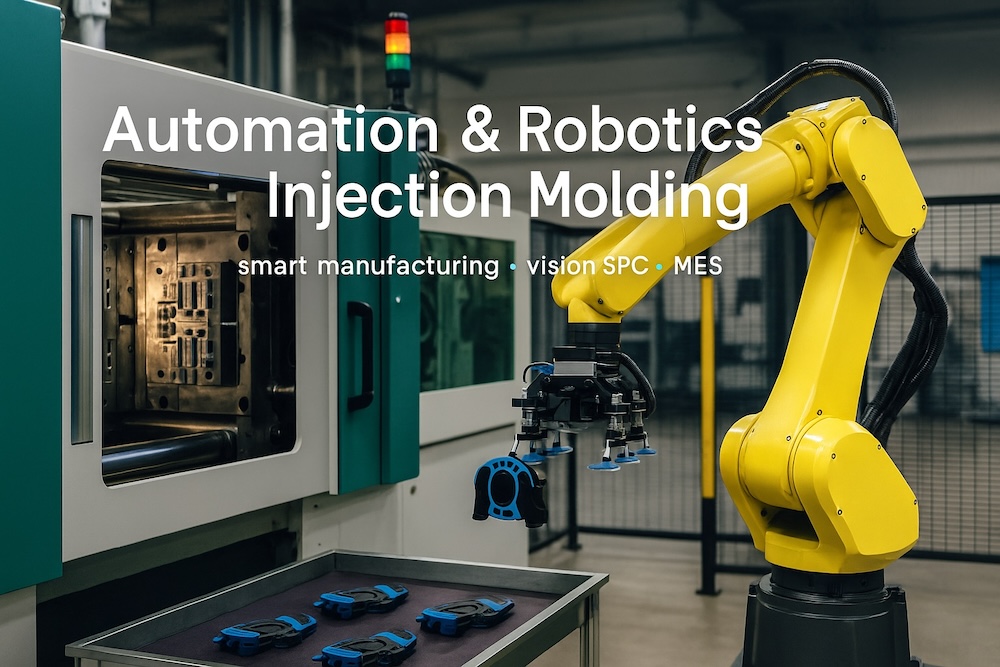The Role of Automation and Robotics in Modern Injection Molding Factories
The Role of Automation and Robotics in Modern Injection Molding Factories

The Role of Automation and Robotics in Modern Injection Molding Factories
injection molding automation • smart manufacturing • robotic injection molding
Automation is no longer a bolt-on accessory—it’s the operating system of competitive molding plants. The right mix of robotics, vision, MES, and sensorized tooling lifts throughput, lowers labor cost, stabilizes quality, and shortens time-to-scale. With the TaiwanMoldMaker.com network, you can implement a modular, auditable roadmap from prototype cells to lights-out runs.
Explore our end-to-end path from DFM to automated production:
Custom Mold & Design Maker • Mold Service • Injection Mold • Molding • Customer Examples • Contact
Why Automate Injection Molding?
-
Throughput & uptime: faster take-out, shorter changeovers (SMED), fewer stoppages.
-
Quality at speed: vision SPC and cavity pressure guardrails reduce escapes and rework.
-
Labor reallocation: robots handle repetitive/dexterous tasks; operators move to value-add QC and maintenance.
-
Traceability & ESG: MES consolidates OEE, CpK, scrap, energy (kWh/kg) with lot genealogy.
See how we integrate automation into real programs: Molding • Examples: Customer Examples
The Automation Stack (What a Modern Cell Looks Like)
| Layer | What’s Inside | Why It Matters |
|---|---|---|
| Robotics | 6-axis, SCARA, Cartesian; EOAT for take-out, insert-load, degate | Shorter cycles, consistent handling |
| Inline Processes | Pad print, laser mark, ultrasonic weld, leak-test, cut/trim | Eliminates extra moves & WIP |
| Sensing | Cavity pressure, near-wall thermocouples, flow/ΔT on cooling | Scientific molding control |
| Vision SPC | 2D/3D cameras for flash/shorts/gate blush/color ΔE | 100% inspection at speed |
| MES | OEE, CpK, scrap, energy, genealogy, API to ERP | Real-time decisions, audit trail |
| Logistics | AMR/AGV to move trays; smart racks & labels | Low touch, fewer handling errors |
Plan the architecture in 48 hours with DFM + cell concept: Custom Mold & Design Maker
Robots in the Press: Where They Pay Back
-
High-speed take-out & stack: shave 0.5–1.5 s per cycle; protect A-surfaces.
-
Insert molding: metal pins, threaded inserts, batteries/PCBs for hybrids; poka-yoke nests.
-
2K/overmold transfers: synchronized robot handoff between stations.
-
Family tools: smart picking by cavity/variant; barcode/QR traceability.
-
Heavy parts & large tools: safe demold with end-effectors tuned for CG and stiffness.
See our tooling interfaces and EOAT options: Injection Mold • Build & service: Mold Service
From “Automated” to Smart Manufacturing
Smart manufacturing connects the cell so it can measure, decide, and document:
-
Scientific molding: transfer from velocity to pressure using cavity pressure, not just screw position.
-
Golden recipe: guarded setpoints for fill/pack/cool; envelopes for pressure curves; auto-containment when out of bounds.
-
Vision + MES: classify scrap by cause, trigger alerts, and log every lot into genealogy.
-
Energy dashboards: kWh/kg per SKU; cooling ΔT and flow stability reports.
Get the data layer right on Day 1: Molding
Lights-Out (Dark) Factory: What’s Realistic?
A “lights-out” line doesn’t mean zero humans—it means humans on exceptions. Practical scope:
-
Stable SKUs: validated molds with valve gates, balanced cooling, and robust EOAT.
-
Inline finishing: mark/weld/trim with vision confirmation and torque/force checks.
-
Autonomous logistics: AMR/AGV moves totes; MES schedules pallets; printers apply labels.
-
Remote dashboards: alarms for pressure envelopes, cycle drift, or energy spikes.
-
Preventive maintenance: vibration/temperature sensors; quick-swap spares and standard components.
See dark-run snapshots: Customer Examples
Case-Style Results (Representative)
| KPI | Conventional Cell | Automated + Smart Cell |
|---|---|---|
| Cycle time (ABS housing) | 28.5 s | 21.8 s |
| Scrap rate | 2.9% | ≤ 0.9% |
| OEE | 68% | 88–92% |
| Energy (kWh/kg) | 0.65 | 0.45 |
| Direct labor / press | 1.8 FTE | 0.6–0.9 FTE |
Actuals vary by tool, resin, and automation scope.
See comparable programs: Customer Examples
Design-for-Automation (DFA) Checkpoints
-
Grippable features: tabs/landings that EOAT can hold without marring.
-
Gate & vestige control: valve gates or fan/film away from EOAT contact; auto-degate where possible.
-
Cooling symmetry: ΔT ≤ 5 °C; consider conformal cooling for flatness and cycle.
-
Insert nests: chamfers, lead-ins, and poka-yoke geometry for robots.
-
Vision fiducials: consistent reference edges/marks; define pass/fail rules up front.
Bake these into your 48-hour DFM: Custom Mold & Design Maker • Tool execution: Mold Service
Automation Options & Payback Matrix
| Option | What It Does | Typical Payback | Best For |
|---|---|---|---|
| EOAT take-out + stacker | Faster demold, no scuff | 6–12 mo | Thin skins, A-class parts |
| Insert-load robot | Precise placement, fewer misses | 9–18 mo | Metal-plastic hybrids |
| Vision SPC | 100% cosmetic/dimensional checks | 6–12 mo | Brand surfaces, tight CTQs |
| Sequential valve gating | Weld relocation, balance | 12–24 mo | Long-flow, multi-cavity |
| Conformal cooling | −8–20% cycle, warp↓ | 9–18 mo | Hot-spot geometries |
| AMR/AGV | Low-touch logistics | 12–24 mo | Multi-press cells |
| MES + energy | OEE↑, kWh/kg↓ | 6–12 mo | Any high-runner SKU |
Run side-by-side ROI in your DFM pack: Custom Mold & Design Maker
Implementation Roadmap (Fast & Defensible)
-
Upload CAD & targets (volumes, CTQs, automation scope).
→ Custom Mold & Design Maker -
48-Hour DFM & Cell Concept (gates/cooling/EOAT/vision/MES) + cycle & labor model.
-
Tool build (aluminum → hybrid → steel) with sensor ports and EOAT interfaces.
→ Mold Service -
Scientific trials: cavity-pressure DOE; lock golden recipe; add vision rules.
→ Molding -
Pilot automation: dry-run AMR/AGV, labels, packing; finalize pallet map & COA.
-
Scale & replicate: copy-cavity to steel; deploy the same guarded recipe & MES rules.
→ Examples & metrics: Customer Examples
RFQ Template (Copy/Paste)
Subject: RFQ – Injection Molding Automation & Smart Cell Integration
Attachments: STEP/IGES + 2D with CTQs & cosmetic map
-
Annual volume & first PO qty; SKU/color count
-
Tooling strategy (cavity count; valve vs. cold runner; conformal cooling candidates)
-
Automation scope (EOAT take-out, insert load, in-cell process: print/laser/weld/leak)
-
Vision SPC needs (cosmetics, dimensions, ΔE/gloss; sample rate vs. 100%)
-
Sensors (cavity pressure/TC), MES dashboards, energy (kWh/kg) reporting
-
Packaging/labels (trays/boxes, barcode/QR, genealogy requirements), pallet map
-
Validation (FAIR, CMM/scan, GR&R, CpK @ CTQs targets), PPAP/IQ-OQ-PQ if needed
-
Milestones (T0/T1/buy-off/SOP) & Incoterms
Need help shaping the RFQ?
→ Custom Mold & Design Maker • Quotes & timing: Mold Service • Engineering chat: Contact
FAQ
Do small runs justify robots?
Yes—modular EOAT and shared bases lower capex; you can redeploy robots across SKUs. See pilot-to-production paths in Molding.
How do we avoid “automation brittleness”?
Design EOAT for tolerance; add vision to verify states; keep manual bypass plans; standardize spares. Review our tooling standards in Injection Mold.
What about training and maintenance?
We include PM schedules, spare kits, and operator playbooks; see real outcomes in Customer Examples.
Why TaiwanMoldMaker.com
-
Integrated approach: tooling, robots, vision, and MES planned together.
-
Proven cells: valve-gated hot runners, conformal cooling, EOAT libraries, inline finishing.
-
Auditable quality: scientific molding (cavity pressure), FAIR/CMM/GR&R, CpK dashboards.
Dive deeper: Injection Mold • Molding • Customer Examples
Call to Action
Ready to pilot robotic injection molding and scale to smart manufacturing? Send CAD and targets to receive a 48-Hour DFM & Cell Concept Pack—EOAT/vision plan, cycle & labor model, and an implementation schedule.
→ Request an Instant Quote • Start with DFM here: Custom Mold & Design Maker








